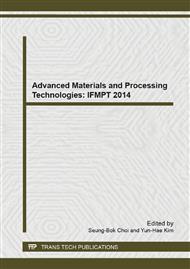[1]
R. Slunjski, I. Capan, B. Pivac: Effects of low-temperature annealing on polycrystalline silicon for solar cells, Solar Energy Materials and Solar Cells, Vol. 95 (2011), pp.559-563.
DOI: 10.1016/j.solmat.2010.09.016
Google Scholar
[2]
A. Asgari, K. Khalili: Temperature dependence of InGaN/GaN multiple quantum well based high efficiency solar cell, Solar Energy Materials and Solar Cells, Vol. 95 (2011), pp.3124-3129.
DOI: 10.1016/j.solmat.2011.07.001
Google Scholar
[3]
S. K. Natarajan, T. K. Mallick, M. Katz, S. Weingaertner: Numerical investigations of solar cell temperature for photovoltaic concentrator system with and without passive cooling arrangements, International Journal of Thermal Sciences, Vol. 50 (2011).
DOI: 10.1016/j.ijthermalsci.2011.06.014
Google Scholar
[4]
P. Balraju, P. Suresh, Manish Kumar, M.S. Roy, G.D. Sharma: Effect of counter electrode, thickness and sintering temperature of TiO2 electrode and TBP addition in electrolyte on photovoltaic performance of dye sensitized solar cell using pyronine G (PYR) dye, Journal of Photochemistry and Photobiology A: Chemistry, Vol. 6 (2009).
DOI: 10.1016/j.jphotochem.2009.05.014
Google Scholar
[5]
A. E. Shalan, M.M. Rashad, Youhai Yu, Mónica Lira-Cantú, M.S.A. Abdel-Mottaleb: Controlling the microstructure and properties of titania nanopowders for high efficiency dye sensitized solar cells, Electrochimica Acta, Vol. 89 (2013), pp.469-478.
DOI: 10.1016/j.electacta.2012.11.091
Google Scholar
[6]
A. Taghinia, F. Yazdi, P. Fazel, S. N. Anousheh: Comparison of single junction GaAs and In0. 2Ga0. 8N based solar cells at various temperatures, Energy Procedia, Vol. 14 (2012), pp.919-924.
DOI: 10.1016/j.egypro.2011.12.1033
Google Scholar
[7]
P. Singh, N. M. Ravindra: Temperature dependence of solar cell performance—an analysis, Solar Energy Materials and Solar Cells, Vol. 101 (2012), pp.36-45.
DOI: 10.1016/j.solmat.2012.02.019
Google Scholar
[8]
Y. Qiu, O. Kunz, A. Fejfar, M. Ledinský, B. Teik Chan: On the effects of hydrogenation of thin film polycrystalline silicon: A key factor to improve heterojunction solar cells, Solar Energy Materials and Solar Cells, Vol. 122 (2014), pp.31-39.
DOI: 10.1016/j.solmat.2013.11.017
Google Scholar
[9]
M. Berginc, U. Opara Krašovec, M. Jankovec: The effect of temperature on the performance of dye-sensitized solar cells based on a propyl-methyl-imidazolium iodide electrolyte, Solar Energy Materials and Solar Cells, Vol. 91 (2007), pp.821-828.
DOI: 10.1016/j.solmat.2007.02.001
Google Scholar



